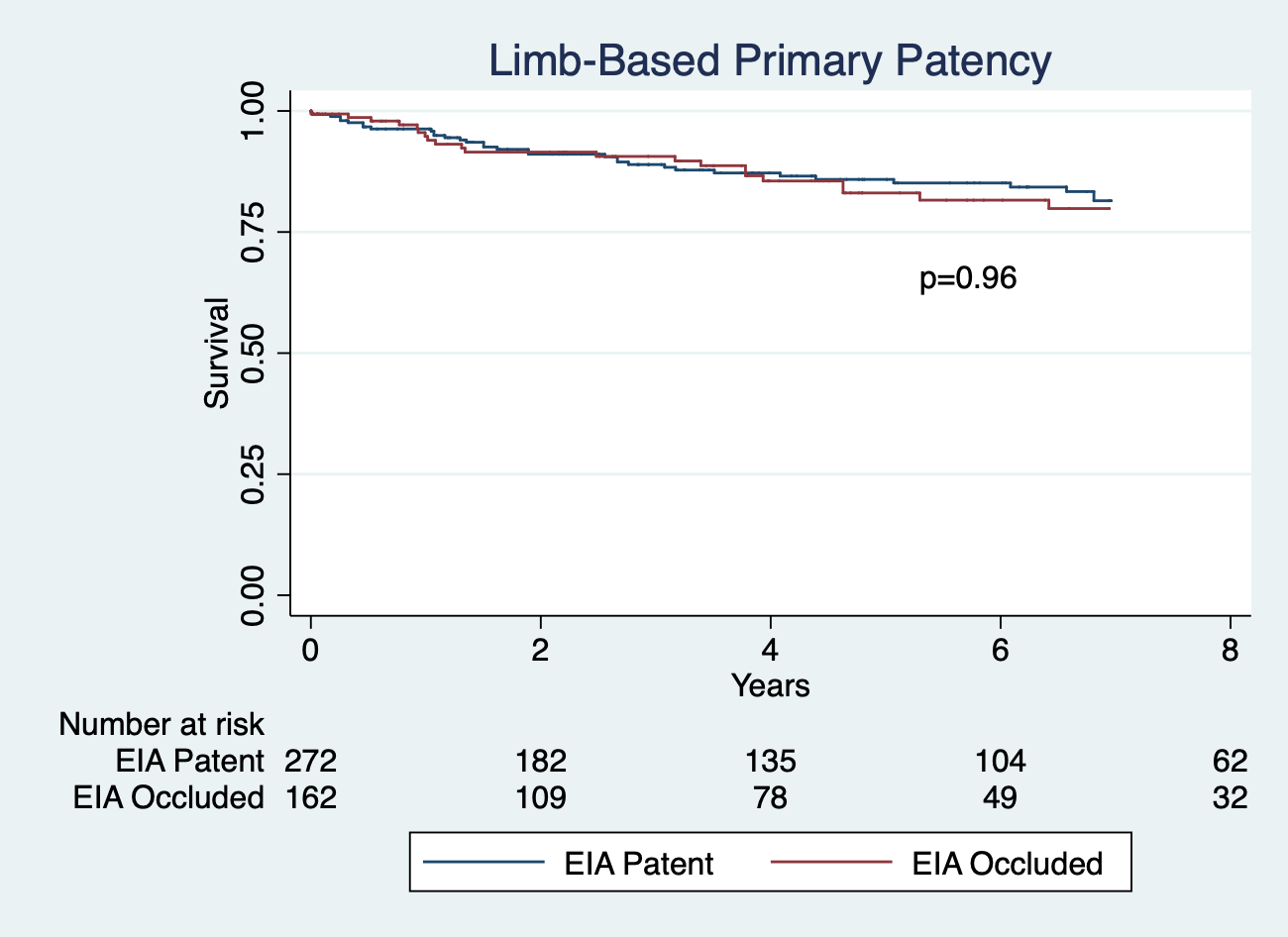The Effect Of Retrograde External Iliac Artery Runoff On Aortofemoral Bypass Limb Patency
Charles DeCarlo, MD, Ryan Gifford, Laura T. Boitano, MD MPH, Jahan Mohebali, MD, W. Darrin Clouse, MD, Mark F. Conrad, MD MMSc.
Massachusetts General Hospital, Boston, MA, USA.
Background: Superficial femoral artery (SFA) and profunda patency has been shown to affect aortofemoral bypass (AFB) limb patency. However, the effect of retrograde flow through the external iliac artery (EIA) is unknown and is the subject of this analysis.
Methods: Institutional AFB data from 2000-2017 were gathered, excluding those where SFA/EIA patency could not be determined. The cohort was divided into limbs with and without EIA occlusion; primary outcome was limb-based primary patency. Kaplan-Meier estimated patency; cox proportional-hazards model evaluated EIA patency while controlling for other factors.
Results: Over the study period, there were 557 limbs in 281 patients. Of the 435 limbs in 220 patients that met inclusion criteria and were included in the analysis, 162 had EIA occlusion and 273 had a patent EIA. Mean age was 69.6±9.0. EIA occlusions were more common in male patients (59.9% vs 44.6%; p=0.001), patients with CAD (43.8% vs 34.1%; p=0.042), COPD (34.6% vs 20.5%; p=0.001), and CHF (14.8% vs 5.9%; p=0.002). Limbs with EIA occlusions more often underwent end-to-side proximal anastomosis (40.7% vs 24.2%; p<0.001) and simultaneous infrainguinal bypass (7.4% vs 0.7%; p<0.001). Median follow-up was 4.6 years (IQR: 1.6-8.4). Five-year primary patency was 83.1% (95%CI: 74.5%-90.0%) for EIA occlusion limbs and 85.9% (95%CI: 80.2%-90.0%) with patent EIA limbs (p=0.96, Figure). While controlling for other factors, EIA occlusion did not affect primary patency (Table). For patients with a proximal occlusion (occluded aorta, occluded common iliac, or end-to-end proximal anastomosis) and occluded SFA (N=73), EIA occlusion had a HR of 1.92 for loss of patency, but this was not statistically significant (p=0.39)
Conclusion: EIA patency did not influence primary patency in the overall cohort. EIA patency may contribute to graft failure in patients with an SFA occlusion, but this needs further study in a larger population.
| Table: Multivariable Cox Model for Primary Limb-Based Patency | ||||
| HR | 95% CI | p-value | ||
| EIA Occlusion | 0.83 | 0.45 | 1.53 | 0.553 |
| SFA Occlusion | 2.12 | 1.11 | 4.03 | 0.022 |
| Age (Per each Increasing Year) | 0.97 | 0.94 | 1.00 | 0.037 |
| Female Sex | 1.70 | 0.92 | 3.14 | 0.091 |
| History of VTE | 4.04 | 1.20 | 13.63 | 0.024 |
| Pre-op Statin | 0.49 | 0.26 | 0.92 | 0.027 |
| Simultaneous Infrainguinal Bypass | 3.71 | 1.13 | 12.21 | 0.031 |
| Abbreviations: EIA = external Iliac Artery, SFA - superficial femoral artery, VTE - Venous Thrombotic Event | ||||

Back to 2021 Abstracts
